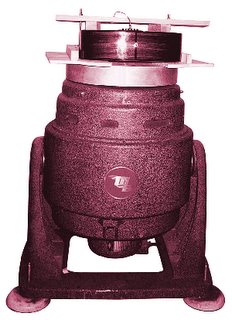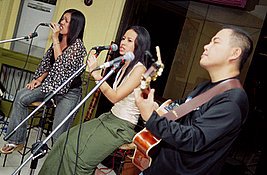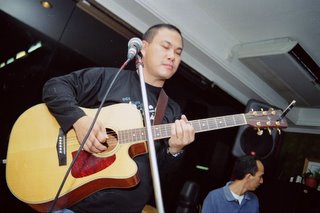A lot of people get confused when they watch my band's performances. There are only three of us in 220, Ellen, Kukie, and myself (on guitar), but our sound is closer to a full band than to the regular one-guitar band/soloista. There are two reasons for this: first, Ellen and Kukie are wonderful singers who can take audiences through a whole range of emotions in one gig, and second, I have a “secret weapon” that lets me sound like I'm playing several guitars at the same time.
The secret? My Line 6 DL4 Delay Modeler. Its main use, as its name denotes, is as a delay gadget, 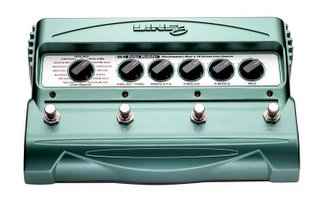 and in this function it shines and gives the guitarist a whole bag of tricks that adds dimension to the sound. It has vintage delays as well as modern ones, and by these alone the DL4 stands out and is worth the money.
and in this function it shines and gives the guitarist a whole bag of tricks that adds dimension to the sound. It has vintage delays as well as modern ones, and by these alone the DL4 stands out and is worth the money.
But for me and many of those who use it, the DL4's claim to fame is its loop sampler. I can record a bass part, loop that, lay down a rhythm track, loop the two, lay down a few more tracks, loop them all, and then play a lead over the whole thing. This can go on indefinitely (until I get tired), and the net effect is a guitar player jamming with himself. It's great to watch, but even greater to be the one playing the entire solo ensemble.
SOLO JAM
My loopiness began a few years ago when I first saw my idol Phil Keaggy performing at a TV show (I was already a fan by then but hadn't seen any of his performances). I was floored because he appeared to be recording some parts on the fly and layering them to form a background for his solos. He sounded like a full band, complete with drums (by slapping on his Olson's soundboard), bass, rhythm and lead guitars, and vocals. And with volume swells courtesy of a volume pedal, he even spliced in some violin- and flute-sounding parts. The most jaw-dropping part was him singing into his guitar sound hole (his guitar had a built-in microphone) and looping his own voice!
Intrigued, I researched Phil Keaggy's performances and discovered he was using the Lexicon Jamman. Unfortunately by that time the Jamman had been discontinued, and when I looked at other loopers their prices immediately turned me off.
It wasn't until late last year that I began to search for a looper in earnest. That was spurred again by Phil Keaggy, whose live DVD I had just received as a gift from my sister in Canada. I searched the net for products that could let me do loops, and I found a few that weren't so expensive. Unfortunately they were not available in the Philippines, and I was forced to postpone my search once again.
Some time later an American friend, Sean, said he was going to see Phil Keaggy in concert, and I asked him to ask Phil what looper would recommend for me. Phil's answer was quick: the Line 6 DL4 Delay Modeler. Hearing it from the master guitarist himself, I prayed to the Master Of All for a DL4, although I was quite sure it was a long shot. Meanwhile I researched the product and imagined myself using it.
In April I made a work-related trip to Manila, and on one of the breaks I went to the mall to check out Perfect Pitch for any new offerings. Lo and behold, on display was a DL4, and I immediately tested it. I think all the practicing I did in my mind made me something of a looper already because using the DL4 came naturally to me; pretty soon a small crowd was gathered around me, listening to me playing “I Could Sing Of Your Love Forever.”
Unfortunately I didn't have the money that time, and I had to wait until another trip to Manila the next June. It was just as well since by that time there was a sale at Perfect Pitch and my youngest brother had a P1,000 discount card, so I ended up paying P5,000 less for my DL4.
I've been using the DL4 for about six months now and it has served me well all this time. I should also say that it is what makes my band 220 even possible: as a one guitar-band we need the extra sound the DL4 makes possible. Our shows/gigs are a mix of vocals and instrumentals, and I am able to do the latter through my looper. Why don't I just tap another guitar player? Well that's really stuff for another blog entry, but the long and the short of it is that I have yet to find an acoustic guitarist who thinks and plays like I do. As long as I haven't found him or her, I'll just keep on jamming with myself.
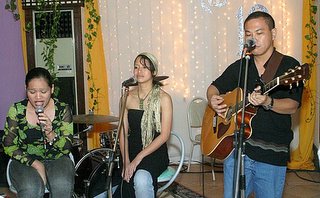 band 220 played Saturday night, November 26 (don’t you just hate long sentences?). Ellen at left is belting out her part in “Summer Breeze” by Seals and Croft (I can tell that’s the song from the position of the capo; the only other song we sing in that capo position is “Cool With You” by Jennifer Love Hewitt, but Ellen has no solo part there) while Kukie in the middle waits her turn.
band 220 played Saturday night, November 26 (don’t you just hate long sentences?). Ellen at left is belting out her part in “Summer Breeze” by Seals and Croft (I can tell that’s the song from the position of the capo; the only other song we sing in that capo position is “Cool With You” by Jennifer Love Hewitt, but Ellen has no solo part there) while Kukie in the middle waits her turn.


